Disclosure: Meeple Mountain received a free copy of this product in exchange for an honest, unbiased review. This review is not intended to be an endorsement.
Harry Potter: House Cup Competition is a light strategy worker placement game for 2-4 players. In this game players each select a house and send their Students (read: workers) to attend classes and complete lessons in order to upgrade their skills.
How it Works
The game is played over 7 rounds (because it’s Harry Potter themed, so of course it is). Each round has 2 phases: Classes and Challenges. In the first phase, Classes, players take turns placing 1 of their 3 Students on the board and optionally completing a Lesson (either before or after placement). Lessons are cards that will require some level of skill in one of the three subjects (Potions, Charms, and Defence Against the Dark Arts) and will give the active player a reward when they are complete.
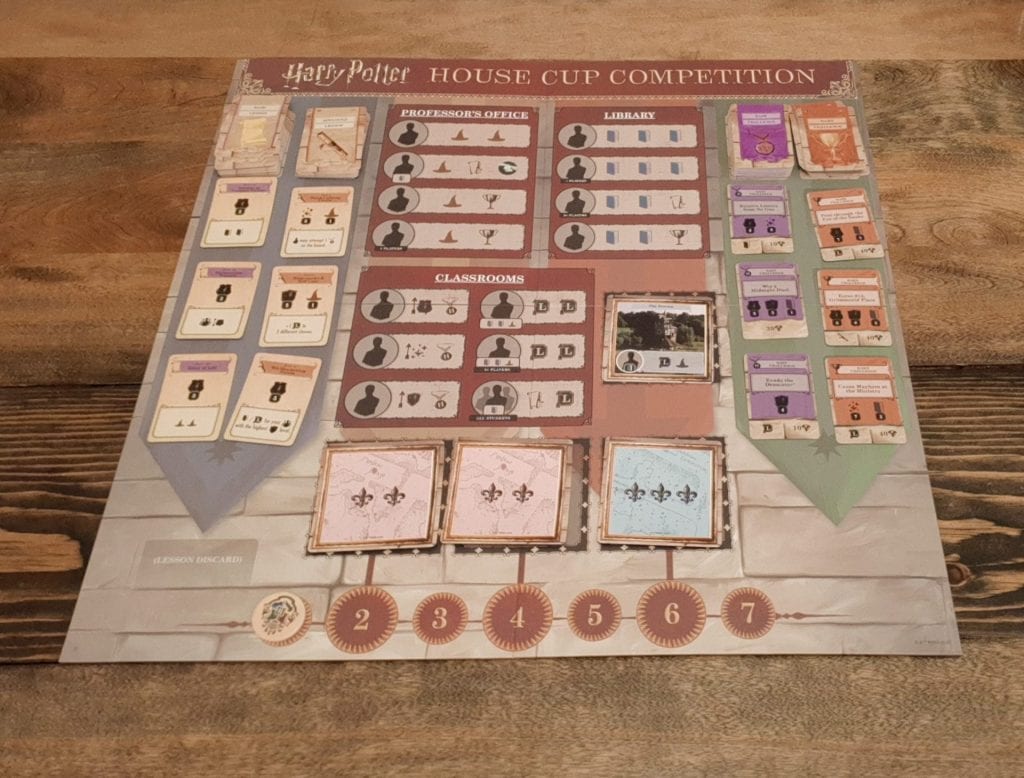
During the first phase of a round, there are 4 areas of the board where Students can be placed: the Library, Professor’s Office, Classrooms, or any face-up Location. Each area will have multiple spots for workers, some with costs and some that are free. I’ll quickly go over what can be gained from each area of the board.
- Library: Here Students can collect Knowledge, which is one of two resources in this game and represented by a book. Knowledge can be used to access certain spots on the board and may be required for certain Lessons or Challenges (more on this later). Half of the spots will also grant the player either a new Lesson or Challenge Card.
- Professor’s Office: Here Students can collect Magic, the other resource. Along with all the same uses as Knowledge, Magic can be used to temporarily boost a Student’s skill level in a subject to complete a Lesson or Challenge. Some spots will also grant the player a new Lesson or Challenge Card. This is also where the First Player token can be claimed.
- Classrooms: Here Students will increase their skill levels in the subjects (up to a maximum skill level of 7). The spots will either offer a level in a specific subject and an Easy Challenge Card, or 2 levels in subjects of your choice for the price of 2 Knowledge and 1 Magic. All spots in the game are limited to a single Student except for the last spot in the Classroom section, which for the price of a Knowledge offers the Student a level in the subject of their choice and a Lesson Card.
- Locations: The game begins with 1 visible Location and 3 more will be revealed over the course of the game. Locations are meant to add variety to the game and each has some sort of requirement that must be met to use, whether it be paying resources or a minimum skill level.
Once each player has placed all three of their Students, Phase 1 ends and Phase 2 begins.
In Phase 2 players will complete Challenge Cards in turn order. There are 2 tiers of Challenge Cards, Easy and Hard. Each Challenge will require a certain skill level in a subject and may also require Knowledge or Magic. A player can complete up to 2 Challenges on their turn and they may use all of their Students. Students can combine their skill levels to complete a Challenge; however, each Student can only be assigned to one Challenge per round. Once a Challenge is complete the player will gain some number of points and potentially resources. Students are then returned to individual player boards and the next round begins.

After 7 rounds the game is complete. In addition to the points players received during the game they will get 1 gem (representing 10 points) for each subject any of their Students reached level 7 in and for each complete pair of Magic and Knowledge tokens they have left. The player with the most points wins.
Thoughts
I’m going to come right out and say it: I did not enjoy this game. If you want to play a light strategy worker placement game, there are better games out there. If you want to play a Harry Potter themed game, there are better games out there. If you want to know the reasons I don’t recommend this game, read on.
First I’ll touch on the gameplay. There is no feeling of challenge or strategic thinking. As a friend noted, “I feel like none of my decisions matter”. There is no real urgency to go to certain spots because the Lesson and Challenge Cards refill, so it’s not like you’ll miss out on getting one, and there is always the option to go to the spot where an unlimited number of Students can be placed if you’re in trouble (unless you’re out of Knowledge tokens, but no one I played with ever faced this predicament). There was so little competition for spots that the First Player token only ever changed hands once in the 4 player game I played.
Now, there are a lot of mediocre fandom games out there, but for the most part they at least make them visually stimulating because that’s what sells them: the trademarked characters and images. It’s ironic, then, that Harry Potter: House Cup Competition is an ugly game. For some reason, the board is set on a brick wall and there is essentially no specific Harry Potter artwork or images other than the omnipresent ™ next to certain character and location names. The only thing that is nice to look at in this entire game is the “House Cup Hourglass Display”, a gem-based way to count points.
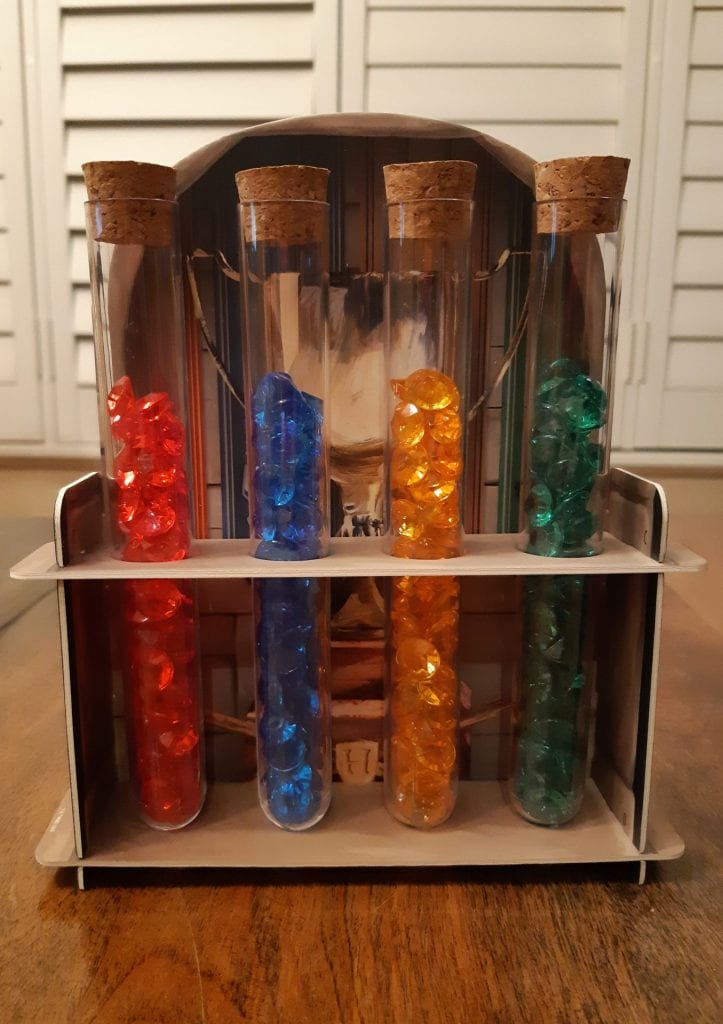
On top of the design being ugly, it’s also just bad. For instance let’s talk about the individual player boards. Here you have different areas to track each Student’s progress in their subjects. These areas are titled with the Student’s name. The worker is a picture of the Student’s face (from the movie). It’s important to know which token is which, because it will matter when placing your Students and completing Challenges. You probably know what Harry, Hermione, and Ron look like. But how on earth can you expect anyone to keep track of Crabbe and Goyle as separate entities? This could have easily been fixed by either printing the Student’s name on the back of the token or including a picture on the player board… but alas. Also, the markers that are meant to keep track of the Student’s skill levels bump really easily. So that’s a bit annoying.
The board itself is also a victim of bad design. Certain spots are eliminated in 2 and 3 player games in order to scale the game, but where these spots are placed is confusing. In the Professor’s Office, it makes sense. The last spot is the 4 player only spot. But right next door at the Library, the middle 2 spots are the 3+ and 4 player spots. It’s just weird. Another issue is the symbol for the Easy Challenge Cards. This symbol is a medal with an H in it, for Hogwarts. While I had no problem understanding this, 2 out of 4 players did because, as my husband so astutely pointed out, “H stands for Hard, guys”. Also, there is a single discard spot for Lesson Cards (despite there being room for each type) meaning you have to sort through them at the end of the game. So that’s a bit annoying.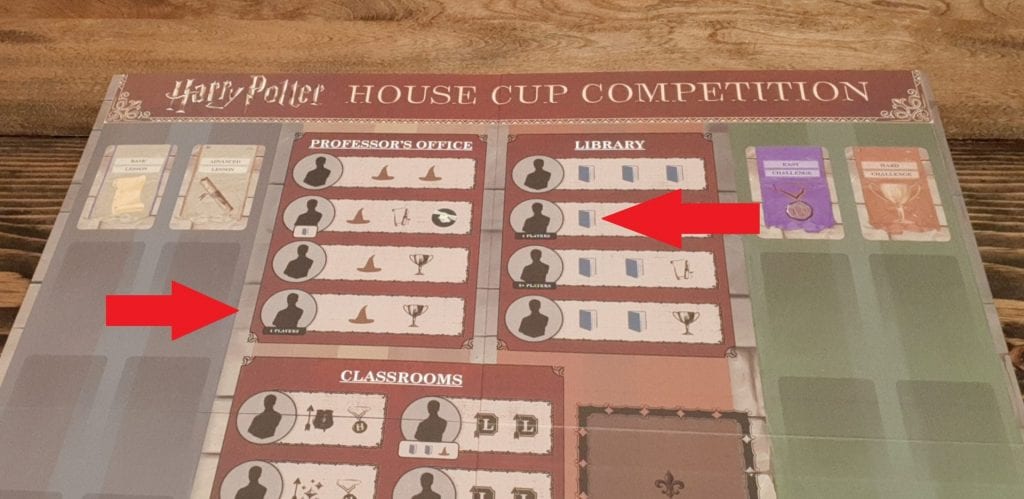 Now, I never like to judge a game unfairly, so I made sure to play it at multiple player counts to see if it was any better. And I have to say, the 2 player game was better…but that’s only because it was shorter. But even then there were some aspects that were problematic in a 2 player game. Since there are fewer players taking cards, the available cards remained relatively stagnant. There were a couple Hard Challenge Cards that neither player wanted, so these cards occupied 2 of the 3 slots for most of the game. There is no way to cycle Challenge Cards without spending a Student to take one, so it felt we may as well be grabbing the top card from the deck. As you may have guessed, I found this a bit annoying.
Now, I never like to judge a game unfairly, so I made sure to play it at multiple player counts to see if it was any better. And I have to say, the 2 player game was better…but that’s only because it was shorter. But even then there were some aspects that were problematic in a 2 player game. Since there are fewer players taking cards, the available cards remained relatively stagnant. There were a couple Hard Challenge Cards that neither player wanted, so these cards occupied 2 of the 3 slots for most of the game. There is no way to cycle Challenge Cards without spending a Student to take one, so it felt we may as well be grabbing the top card from the deck. As you may have guessed, I found this a bit annoying.
What if you just really like Harry Potter? Well, I’m sorry to say, there’s no magic here. I quite like Harry Potter and for me that was actually another problem with this game. The theme is so loosely applied that I didn’t feel immersed in it at all. Some Challenges and Classes have okay references, but others are lazy, unimaginative and poorly executed. It seems like whoever applied the theme either knows very little about Harry Potter or was just apathetic. I think for some of the Challenge Cards they actually just reused names of book chapters. This makes no sense thematically, since you are playing as Hogwarts students and not necessarily Harry’s inner circle. If you’re playing with 4 players, some unlucky soul is going to have to play as Hufflepuff. Because the characters are divided by House, everyone’s favourite trio — Harry, Ron & Hermione — will fall to a single player. Someone else will be stuck with Cedric, Hannah Abbott, and a third character (who I could look up, but honestly, not remembering kind of furthers the point). And no disrespect to Hufflepuff, but it’s pretty unlikely that this trio is your Hogwarts dream team.

Unfortunately Harry Potter: House Cup Competition is a very mediocre game with a Harry Potter theme slapped on it. I can’t in good conscience recommend it to anyone. If you want a game that is both good and Harry Potter themed, you should check out Harry Potter: Hogwarts Battle. If you just want a Harry Potter game, you’re probably better off to go with any of the other Harry Potter games that the The Op has published. In summary, Harry Potter House Cup Competition is a squib pretending to be a wizard.
Six Month Update
Once the review was published I gave this game away. It wasn’t for me and I knew that it wouldn’t ever make it to my table again.


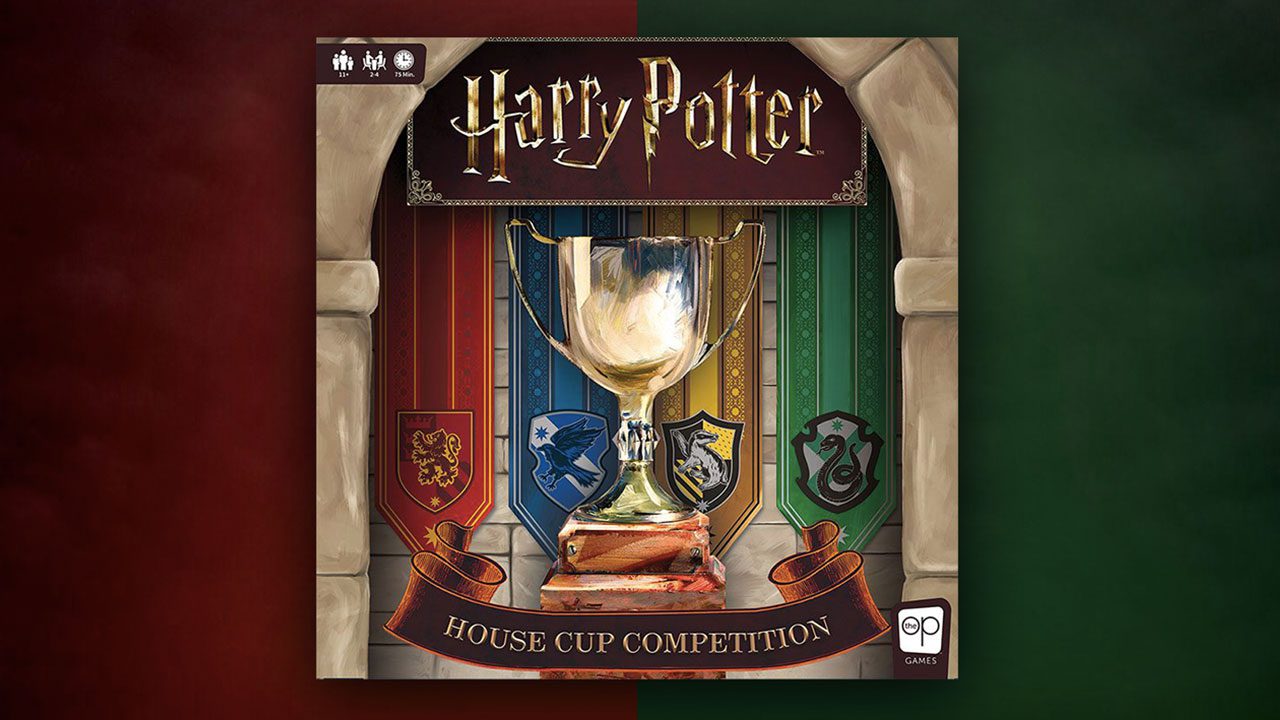


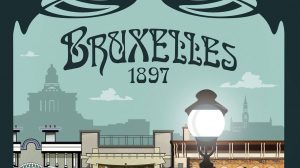
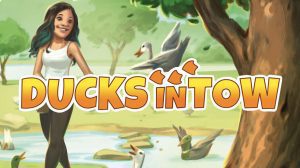





Your assessment seems spot on. I will add that if you are a game designer and you are going to make a game with a Harry Potter theme, you should at least make it look interesting; the game should at least be pleasant to view. The images you have provided in this review gives me the impression that this game is so completely generic as to be pointless.
Perhaps the next game produced by these graphic designers will be: “Board Game, Generic, One Each”
Thanks for the review. I think I will pass on this one.
Thanks for the comment, Kenneth. I especially enjoyed “Board Game, Generic, One Each”. My husband and I had a good laugh at that.